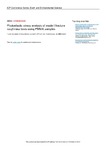Mostrar o rexistro simple do ítem
Photoelastic Stress Analysis of Mode I Fracture Toughness Tests Using PMMA Samples
| dc.contributor.author | Muñoz-Ibáñez, Andrea | |
| dc.contributor.author | Herbón-Penabad, Miguel | |
| dc.contributor.author | Delgado Martín, Jordi | |
| dc.date.accessioned | 2022-01-11T20:08:08Z | |
| dc.date.available | 2022-01-11T20:08:08Z | |
| dc.date.issued | 2021 | |
| dc.identifier.citation | A Muñoz-Ibáñez et al 2021 IOP Conf. Ser.: Earth Environ. Sci. 833 012031 | es_ES |
| dc.identifier.uri | http://hdl.handle.net/2183/29358 | |
| dc.description.abstract | [Abstract] Rocks are usually inhomogeneous and anisotropic materials. The presence of foliation planes, grain boundaries or even microcracks may alter the stress distribution. In order to identify whether unusual behaviours in rocks are due to these imperfections or result from other factors (e.g. experimental configuration), the analyses of homogenous and isotropic materials is an useful approach. We have performed a series of mode I fracture toughness (KIC) tests using polymethyl methacrylate (PMMA) samples, which has the advantage of allowing photoelastic stress analysis based on its birefringent nature. Three different testing configurations were considered in the study: S\ emi-circular bend (SCB) test, the pseudo-compact tension (pCT) test, and a new alternative configuration based on the previous two that we have called pseudo-SCB (pSCB) test. To perform the photoelastic analysis, all the experiments were complemented with a specially-designed experimental setup consisting in two orthogonally arranged circular polarizers placed on both sides of the tested specimens. Using a source of white (polychromatic) light on one end it is possible to record the stress distribution using a digital camera aligned with the samples on the other end. As the load increases, a distinct evolving pattern of colour fringes can be visualized in the samples illustrating the spatially distributed stress levels. Based on this analysis we observe in some of the tests performed non-symmetrical stress fields. Although this behaviour could be related with the testing configuration, results suggest that other features, such as the shape of the notch tip, imperfections in sample preparation, or the misalignment of the samples in the testing device may also have an influence in stress distribution. | es_ES |
| dc.description.sponsorship | This work was funded by the MINECO/AEI/FEDER, UE project BIA2017- 87066-R | es_ES |
| dc.language.iso | eng | es_ES |
| dc.publisher | IOP Publishing Ltd | es_ES |
| dc.relation | info:eu-repo/grantAgreement/AEI/Plan Estatal de Investigación Científica y Técnica y de Innovación 2013-2016/BIA2017-87066-R/ES/ESTUDIO COMBINADO MEDIANTE TECNICAS PETROFISICAS Y EXPERIMENTALES DE PROCESOS TERMO-HIDRO-MECANO-QUIMICOS (THMC) ACOPLADOS A PARTIR ROCAS POROSAS SINTETICAS/ | |
| dc.relation.uri | https://doi.org/10.1088/1755-1315/833/1/012031 | es_ES |
| dc.rights | Atribución 3.0 | es_ES |
| dc.rights.uri | http://creativecommons.org/licenses/by/3.0/ | * |
| dc.subject | Stress | es_ES |
| dc.subject | Fracture | es_ES |
| dc.subject | Rocks behaviour | es_ES |
| dc.title | Photoelastic Stress Analysis of Mode I Fracture Toughness Tests Using PMMA Samples | es_ES |
| dc.type | info:eu-repo/semantics/conferenceObject | es_ES |
| dc.rights.access | info:eu-repo/semantics/openAccess | es_ES |
| UDC.journalTitle | IOP Conference Series: Earth and Environmental Science | es_ES |
| UDC.volume | 833 | es_ES |
| UDC.startPage | 012031 | es_ES |
| dc.identifier.doi | 10.1088/1755-1315/833/1/012031 | |
| UDC.conferenceTitle | Mechanics and Rock Engineering, from Theory to Practice 20-25 September 2021, Turin, Italy | es_ES |






